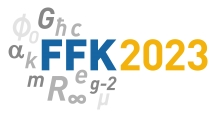Speaker
Description
The energy levels of hydrogen-like atoms and ions are accurately described by bound-state quantum electrodynamics (QED). The frequency of the narrow 1s-2s transition of atomic hydrogen has been measured with a relative uncertainty of less than $10^{-14}$. In combination with other spectroscopic measurements of hydrogen and hydrogen-like atoms, the Rydberg constant and the proton charge radius can be determined. The comparison of the physical constants obtained from different combinations of measurements serves as a consistency check for the theory \cite{Udem2018}. The hydrogen-like He$^{+}$ ion is another interesting spectroscopic target for QED tests. Due to their charge, He$^{+}$ ions can be held nearly motionless in the field-free environment of a Paul trap, providing ideal conditions for high-precision measurements. Interesting higher-order QED corrections scale with large exponents of the nuclear charge, making this measurement much more sensitive to these corrections compared to the hydrogen case. The measurement of a transition in He$^{+}$ will extend the test of QED beyond the long-studied hydrogen. In this talk, we describe our progress towards precision spectroscopy of the 1S-2S two-photon transition in He$^{+}$ \cite{Herrmann2009}. The transition can be directly excited by an extreme-ultraviolet frequency comb at 60.8~nm generated by a high-power infrared frequency comb using high-order harmonic generation (HHG). A femtosecond enhancement resonator with non-collinear geometry is used for this purpose. The spectroscopic target is a small number of He$^{+}$ ions trapped in a linear Paul trap and sympathetically cooled by co-trapped Be$^{+}$ ions. After successful excitation to the 2S state, a significant fraction of the He$^{+}$ ions are further ionized to He$^{2+}$ that remain in the Paul trap. Sensitive mass spectrometry using secular excitation will reveal the number of trapped He$^{2+}$ ions and will serve as a single-event sensitive spectroscopy signal.

